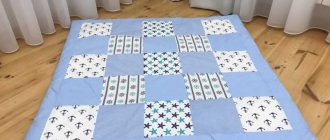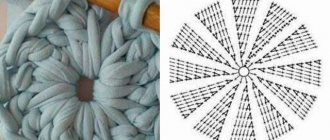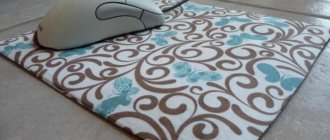Home House and cottage Do it yourself
Recycling plastic grocery bags and plastic shopping bags is nothing new. If you just return the bags for recycling, they will melt them down to make new bags. This releases more pollutants into the air. The fusion of plastic bags with iron causes harmful odors. Scissors come to the rescue.
Creating something beautiful and useful with your own hands brings a sense of pride and achievement. Especially when this new item is built from "garbage" that would otherwise be thrown away. People made rugs from woven strips of fabric and then twisted the braid outward. Plus, in a time of inflated prices, it's a real revelation to find useful material that doesn't cost a lot. Finally, it’s always nice to find a way, no matter how small, to solve your waste disposal problems. You can combine a fun home craft with a little attack on both inflation and today's pollution problem by upcycling polyethylene into knitted rugs. Pre-finished flooring is ideal for protecting the floor of a bathroom or under a sink and is just as good for other uses, both inside and outside the home.
You'll need another 150 bags to make a rug like this, so don't take on this project if you only have a few. Also, if you want multiple colors, you should have bags of different colors. There is nothing difficult about preparing crochet wrappers. Start at the open end of each empty bag and cut a continuous spiral - about an inch wide and around the bag until you reach the part that is glued at the other end. The beginning and end of each stripe should taper to a point. One tool—a single metal hook used for carpet yarn—is the only equipment you'll need to turn even the largest stack of spiral wraps into durable, colorful flooring. Making yarn from woven plastic bags is an upcycled craft. Not only can you turn empty bags into yarn, but you can use the plastic grocery bags that accumulate with every trip to the supermarket to make a round rug.
You can still make a crocheted rug if you don't have weaving equipment (which you probably don't). The result is actually pretty cool, and a great way to use up those bags that would otherwise end up as trash. However, if you don't need a rug, you can also make a napkin, a bag, or even a pair of sandals. Who doesn't have a bin cupboard drawer full of plastic bags just ready to be recycled? Why not combine your package with a utility project to benefit local shelters and the homeless in your area? This is a wonderful project where children and adults of all ages can combine their creativity, talents and hard work to provide sleeping mats for people and organizations that need to brave the elements using plastic yarn from plastic bags.
Why are plastic carpets needed?
Plastic bags are one of the worst offenders of wasteful products that pollute the Earth's oceans and take up limited space. This isn't new information, but Australians still produce around four billion recyclable plastic bags each year. The equivalent of 429,000 plastic bags are dumped into landfills every day; or 7250 are ejected every minute.
Opting for eco-friendly canvas bags for grocery shopping is an effective option, but many people still have excess plastic bags lying around. Instead of throwing them away, you can reuse them by investing them in multi-purpose mats.
In particular, plastic carpet can be used as sleeping mats for people who do not have access to shelter. As sleeping mats they are more hygienic, waterproof, easy to carry and provide protection against concrete. Several charities in Australia have taken up this initiative and have enthusiastically agreed to accept donations of plastic mats that will be redistributed to the homeless. So crocheting improves your quality of life.
Start
Your first step in creating a wrapping mat of any size will be to fold one of the inch-wide strips right down the middle so that it is only half an inch wide. Then lay the hook down and pass the end of the strip under and around the widest part of the handle or shaft of the hook and tie the strip securely with a double knot.
The tape is not actually tied to the shaft, but instead the handle is used as a "spacer" around which the carpet start stitch loop is formed and tied.
Once you have knitted the first loop at the end of your first plastic ribbon, lift the hook in your right hand, hold the broken plastic ribbon to the left and slide the newly formed loop down the tail of the tool until the ring is about an inch from the hook end of your tool . Catch the plastic strip using the winder tool and pull the strip through the knotted ring (thereby forming a second loop). Slide the hook forward for another ribbon bite and pull it back to form a loop. The ongoing series of interlocking stitches you make is called chain stitch, and you can extend the procession indefinitely.
When you have snagged within a few cm of the end of your "yarn", open the folded plastic flat, lay the end of the new strip on it (with about three cm of overlap), fold the two strips together and continue with chain stitch. This way there will be no knots in your finished work. This is the yarn, also called plastic thread, that you will use to knit or knit a plastic mat. The plan is constructed from plastic bags and will be used in the same way as using yarn in crochet.
Variety of crafts
On the Internet you can find a large number of different ways to make beautiful accessories, women’s handbags and much more from old waste materials with your own hands.
Garbage bags, old plastic bottles, CDs - with the right approach, all of this can be used to make various educational toys for children and original crafts.
In addition, you can involve your child in the process and believe me, he will gladly take part in this new activity for him.
Prepare plastic bags
If you decide to knit a carpet from plastic bags, you need to prepare a plastic bag. This article shows you how to create the plastic ribbon needed to create "plastic yarn" that you can use to knit a new bag.
- Trim the bottom seam from the plastic bag.
- Open up as much of the bag as possible. Smooth it out.
- Fold the bag not quite half-width (with the groove perpendicular to the seam you cut). Let one of the edges stick out about an inch. Fold the part you already folded in half, repeating until the folded part does the same.
- Cut off the handles.
- About every cm or 2.5 cm, cut vertical slits into the folded portion of the bag. Make sure you cut all the way through the folded part, but don't try to cut through the unfolded part of the bag.
- Take the unwrapped part of the bag and shake gently. The folded part will unfold into a fringe.
- Open the unfoldable part of the bag and spread the flat one. It helps to slide a piece of cardboard or cardboard tube under the unfolded piece so you don't accidentally cut through the fringe area.
- Make a cut down the center (width) of the unfolded part to the nearest diagonal cut.
- Continue cutting across the unfolded section diagonally, connecting the different cuts.
- The last cut will be similar to the first, ending in the center along the width of the unfolded part. You've just turned a plastic bag into one long, thin strip of plastic.
- Roll the plastic tape into a ball.
Crochet
The second stitch you need to know how to do (and is just as easy to learn as the first) is to assemble the rug using a method known as slip stitch. This is done by passing the hook through the previously formed stitch (while maintaining the loop that is already on the needle) before hooking a new section of ribbon and pulling it through both old loops to form one new one. You'll use this scroll stitch to do something like joining the two ends of a section of chain stitch together.
The only other stitch you need to master to make a rug is called single hook. For the first half of this you will hold the loop on the needle until it is out of the way. You will then take the formed stitch before hooking the new tape grip, which is pulled only through the formed stitch and not through the loop supported on the needle axis. Then one crochet stitch is wrapped by pulling a fresh section of ribbon through both loops on the needle. When you add row upon row to your rugs, you will find that this stitch is almost as important as the main chain stitch.
To start a round rug, line up the quintuple stitch, making sure you don't pull the stitches too tight, and twist the ends of the chain together to form a ring. Now, working through the center of the circle (instead of any of the five individual stitches) for the first half of each and working outside the circle for the second half of each, form enough single crochet stitches—usually about ten—to completely enclose the ring.
Do not stop forming single crochet stitches after completing the cycle. Make the next bottom-up slip stitch used to connect to the ring and continue around the circle, catching - the new row of crochet stitches you just laid down. You'll have to increase the number of single hooks by placing two in every other stitch or so inside. Continue around the developing mat for a few more lines and then lay the piece of work down on a flat surface.
Round
A round rug is suitable even for beginner craftswomen. The main thing here is to be careful, add loops in time and generally follow the pattern. A knitted rug can be multi-colored or plain, but with a contrasting edging - it’s up to you. In the master class, white and blue yarn is used.
Start knitting with five chain stitches. Once you have made them, connect all the loops into a ring. Knit the next loop and turn the product in the other direction. Next you need to make single crochets in each loop of the previous row. A pair of extra stripes is added to the second and fourth. When you reach the turning loop, unroll the mat again. As a result, the mat will close.
To increase the size of the rugs, add five to six loops and knit single crochets. Thanks to this, the product will become wider and will not curl.
Knit the third color in exactly the same way as before. Finish knitting and hide the thread in the closed weave.
How to finish a rug
Continue working around the expanding perimeter until your rug is as large as you want it to be, leaving 3cm of plastic strip hanging from your hook with a few slip stitches. Pull the remaining strip through the last loop and use the crochet hook to stitch from the stitches in the previous row until the strip is used up and none of them are dangling.
Remember that since you will be working around the center (as with a round rug), you will be adding half a centimeter of length for every half centimeter of width, so you should determine the proportions of the finished rug before you begin.
The chain with which you start an oval design should be as long as there is a difference between the length and width of the completed piece. That is, if you need a rug 23 cm long and 14 cm wide, the starting chain should be 8 cm.
To make the technique just described, crocheting a 9cm chain stitch, add three additional chain stitches (for the first turn), a turn and a single back hook (using the top of the 9cm chain stitches as a base). Continue making single crochet stitches right at the end of the series of chain stitches (increase the number of turns if necessary) and continue to knit the rug outward just as you would knit a round design. Increase enough at the ends to keep the rug even and smooth, and stagger the increasing stitches to maintain the oval shape (adding extra stitches at the same points on each round will result in square corners). Finish as you finish the round design.
A square or rectangular rug is made a little differently (working back and forth rather than a round one). Start such a design with a series of chain stitches if there is a desired width for the finished work, then chain three more times, turn and single crochet the next row using the top of the chain stitches as a warp. When you reach the end of the line of single hook stitches, turn (different this time), add another row of single hooks, three times in a row, turn the way you turned the first time, etc.
It's a good idea when you're making a square rug to stop at the end of the first crochet session and count all the stitches in that tier (but not the three chains at either end). Then, as you continue working, check occasionally to make sure you don't increase or decrease the number of stitches you add each time.
You can wash and dry dry wrap mats in the washing machine, but never put them in the dryer. Instead, hang the wet pieces over the line.
Once you have the satisfaction of creating one of these colorful objects, remind yourself again that you received the raw materials for handcrafting for free. And that your recycling efforts have helped limit air pollution. This will probably make you wonder why, when recycling works so well with so little effort on a small scale - big business, government and labor can't make it work on a large scale.
Square
Square rugs also turn out to be very bright and colorful, and making them with your own hands is no more difficult than round ones.
First you need to knit several square blanks. To do this, knit four air loops and close them into a chain. From the center, make eight single crochets, alternating them with chain stitches. Hook the pin in the places where the four corners of the square will be. Knit the second row. At the corners, make a couple of single crochets, a chain loop is knitted between them. Straight lines go without air loops.
Since the rug consists of several identical pieces, you can make it not only square, but also rectangular.
Tools and materials
You will need the following tools:
- Plastic bags.
- Wax paper.
- Iron.
- Scissors.
- Direct contacts.
- Collection of amounts.
You simply save your plastic bags after purchase. If you want a colorful rug, you should collect bags of different colors. The easiest way to do this is to shop in different places. Sometimes the store changes the color of their bags, but this is rare. If you use reusable bags, collecting the bags can be quite challenging. If you really want to do this project, you can ask your friends and neighbors about bags, or you can "borrow" some from the recycling bin at your local grocery store.
The carpet shown in this picture may not be 15 cm long and 17 cm wide, and contains approximately 151 bags. Obviously, for a larger rug you need more bags, and for a smaller rug you need fewer bags.
While blue or yellow bags may be mostly sorted together, white bags tend to have accent colors that can appear in the finished rug.
If you decide to make a carpet with a pattern, then sorting the bags is mandatory. You should look at how many bags of each color you have. As the carpet grows, you will need more bags to go around. Each rug should therefore be different, so use your imagination and your knowledge of your supplies to develop the pattern.
The number of bags needed for each ring varies depending on its size and how tightly you braid it. For example, the inner brown ring has 9 bags, the middle brown ring has 29 bags, and the outer brown ring has 33 bags.
To make comfortable strips, you must cut and fold each bag. The bags are cut along both side seams through the handles. This is the easiest way to get the bag to lay flat, and it also requires the least amount of cutting. Once the bags are cut, you lay the bag open with the original outside (cute side) of the bag facing down. You then fold the long cutting edges inward until the entire strip is about an inch wide. The bags will try to unfurl, but laying them over the back of a chair helps keep them in the correct shape.
If you have very large bags or bags that are thicker material, you can split these bags lengthwise (parallel to the original side seams) to make additional strips.
We prepare high-quality yarn for crafts
Cutting strips
We figured out which bags to choose for making bags or rugs with your own hands. Now let's look at how to prepare the required amount of “yarn”:
- To form knitting threads, you need to cut garbage bags into even strips in accordance with the hook number - the best option is 4–5 cm.
Try to keep the strips even and the same width, then when knitting the surface of the rug will be uniform in thickness.
- To speed up cutting, place several bags in a stack on the table and cut off the strips with a stationery knife along the ruler attached to them.
- Once you have everything cut, straighten one strip and you should have a ring.
From such blanks you will form yarn. There are two ways to do this. Let's look at both options.
Option one
In the first case, all the elements are connected immediately into a ball.
To do this, take one ring, insert another into it, connecting the two edges together, and pull the next strip through them. In this way, all the rings cut from the bags are tied together.
The resulting thread is wound into a ball. In this option, the “yarn” will be thicker and the rug will be more fluffy. But the length of the thread will be slightly shorter.
Option two
Waterproof carpet
Here the length of the yarn will be longer, but the thread itself will be thinner. Which method to choose is up to you.
The principle of preparing knitting thread is as follows. One ring is taken and another is threaded through it. A loop is formed from the second strip by passing one ring through the other, tightening one edge moderately. All other rings are connected in the same way.
In this way, you can prepare yarn of various lengths and individual colors in balls. Everything is limited only by your imagination and desire to make an original rug.
Process
First, start tying the first three strips of bags together. Then place a fairly heavy layer on the knot and then begin braiding. There are only three stripes (bags) in the center, so it won't take much time.
Don't forget to leave a tail for each stripe. This is where you get attached to the next bag. It's actually better if the tails are different lengths because this will force the continuous nodes to be in different places.
To begin shaping the braided bags into a mat, you must lay the braid in a spiral pattern. When you place the braid, use straight pins to temporarily hold the braid together.
You may be better off practicing this step first. Once you have attached the bags to the proper spiral, you are ready to fuse the backing.
The backing is just another plastic bag that has been split apart. You need to have a sheet large enough that everything overlaps. First, place the spiral side down on an iron safe surface. Then place sheets of plastic bags on the back of the spiral.
Be sure to iron only on wax paper. Then wet only on wax paper for a short time. (Time will vary depending on the thickness of each bag). After you separate the iron and wax paper, give the rug a minute or so to cool and harden. If you try to move it while the plastic is still melted, you may ruin the fusion.
As you continue weaving, pinning and merging, there are some things you should be aware of. When you reach the end of the bag, tie the next bag with a square knot (otherwise known as a reef knot). The bags will be tightly compressed so most knots will work.
It is much better if the tails of each bag are tied at different times. When you go to knit the next bag, your knot will make a tiny knot along the braid. This node is very invisible unless all three nodes occur simultaneously. If necessary, cut the strips of the bag so that the tails have different lengths. After the initial cutting, the nodes should fall at different times.
Once you reach the end of your rug, you simply pull the last tails under the rest of the rug and continue the merging process. Once you have merged the rest of the spiral and the final tails, you can trim off the excess support.
While this rug should be quite durable, it is still mostly a showpiece.
Plastic bags as hooked mats using different methods
Weave your own mat from a plastic bag:
Method 1
Materials:
- Fixed support for fabric or store carpets.
- Plastic grocery bags.
- Tool for fixing the latch.
- Latch fastening or adhesive tape.
Instructions:
- Press each bag flat.
- Cut off the handles.
- Make a slit on the side so you have a large, flat piece.
- Cut each flat piece to be 1 to 1 cm wide and 6 to 8 cm long. The easiest way to do this is to fold the cutting bag into a smaller rectangle, folding or folding it in one direction only. Cut this rectangle into strips 1 to 1 cm wide; then wrap these strips around a solid object.
- Attach each strip to the base of the rug using a snap fastener tool (easy instructions can be found online or using snap kits, or ask a fabric store associate).
- Leave a border of about three unhooked rows along the edges of the rug to make the binding more durable.
- Tie down the finished rug using carpet tape. Time required: only about 24 hours over the course of a month.
- Fixed support for fabric or store carpets.
Method 2
What you need:
- Plastic bags.
- 2 or 3 large trash bags.
- Large rectangular piece of cardboard.
- Ruler, pencil, scissors.
The cardboard serves as a loom, and the strips of trash bags create the warp. The finished rug will be approximately 3cm smaller than a piece of cardboard. Cut ½cm wide by 1½cm indentations, spaced 1½cm apart, along the top and bottom of the cardboard. Cut the trash bags open at the sides and then into long 6cm wide strips. Knit the strips together, then create the bases by wrapping them around the flaps created by the cutouts and up and down the length of the cardboard. Tie the beginning and end diagonally across the cardboard box.
To weave grocery bags, secure the handles, cut the sides of the bags to open them, and tie the handles of the first bag to the base in the top corner of the cardboard. Weave the bag inside and outside the base, alternating the pattern with each row. Tie the handles of the second bag to the end of the first, and continue weaving. Be careful not to weave too much or the sides of the rug will start to pull toward the center. When the braiding is complete, press a row or two towards the ends of the warp. Bring the ends together into a mat.
Advantages of a polyethylene carpet
The main advantage of carpets made from garbage bags is the availability of materials. Every housewife has such bags and they are sold in any store. Additionally, the palette of shades of polyethylene products is quite extensive, so there will be no difficulties in choosing. Other advantages:
- Finished polyethylene carpets are wear-resistant. They retain their appearance and remain pleasant to the touch for a long time.
- Polyethylene is resistant to high humidity and temperature changes. When decorating your bathroom interior with this product, you don’t have to worry about it being damaged by water. On the contrary, this material is waterproof and does not absorb liquid.
- Polyethylene rugs are very dense. They do not tear, do not wrinkle or bend. They also do not slip on tiled floors.
- The product is easy to clean. It does not accumulate dirt, so you just need to shake it off or wash it in warm water and soap. At the same time, you won’t have to clean it every day.











